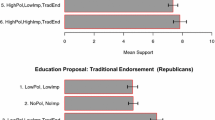Abstract
Although the causes and consequences of the growth of government have become the focus of increasing scholarly attention, relatively little empirical research has been done about the nature and determinants of individual fiscal preferences. The present study analyzes patterns of partisan, socioeconomic, and attitudinal differentiation in public spending preferences for a variety of government functions. Two important findings emerge from our analysis. First, attitudes about the adequacy of government spending for each of the functions considered are shown to have two dimensions—a support for spending dimension and a support for change dimension. Second, the patterns of partisan and socioeconomic cleavages about government spending are shown to vary significantly across policy domains. This fracturing of demand structures, it is argued, may be one of the root causes of the performance crisis of political institutions.
Similar content being viewed by others
References
Axelrod, Robert (1967). “The Structure of Public Opinion on Policy Issues.”Public Opinion Quarterly 31: 51–60.
Beer, Samuel H. (1978). “In Search of a New Public Philosophy.” Pp. 5–44 in Anthony King, ed.,The New American Political System. Washington: American Enterprise Institute.
Brittan, Samuel (1975). “The Economic Contradictions of Democracy.”British Journal of Political Science 5: 129–159.
Cameron, David R. (1978). “The Expansion of the Public Economy: A Comparative Analysis.”American Political Science Review 72: 1245–1261.
Citrin, Jack (1979). “Do People Really Want Something for Nothing: Public Opinion on Taxes and Government Spending.”National Tax Journal 32: 113–130.
Clausen, Aage R. (1973).How Congressmen Decide. New York: St. Martins.
Cooley, William W., and Paul R. Lohnes (1971).Multivariate Data Analysis. New York: Wiley.
Courant, Paul N., Edward M. Gramlich, and Daniel Rubinfeld (1980). “Why Voters Support Tax Limitation Amendments: The Michigan Case.”National Journal 33: 1–19.
Downs, Anthony (1963). “Why the Budget Is Too Small in a Democracy.”World Politics 12: 541–563.
Hibbs, Douglas A., and Henrik Jess Madsen (1981). “Public Reactions to the Growth of Taxation and Government Expenditure.”World Politics 33: 413–435.
King, Anthony (1978). “The American Polity in the Late 1970's: Building Coalitions in the Sand.” Pp. 371–398 in Anthony King, ed.,The New American Political System. Washington: American Enterprise Institute.
Kirkpatrick, Jeane (1976).The New Presidential Elite. New York: Russell Sage Foundation and Twentieth Century Fund.
Kuttner, Robert (1980).Revolt of the Haves. New York: Simon and Schuster.
Ladd, Everett Carll (1976). “Liberalism Upside Down: The Inversion of the New Deal Order.”Political Science Quarterly 91: 577–600.
—— (1979a). “Pursuing the New Class: Social Theory and Survey Data. Pp. 101–122 in B. Bruce-Riggs, ed.,The New Class? New York: McGraw Hill.
—— (1979b) “The Polls: Taxing and Spending.”Public Opinion Quarterly 43: 126–135.
Ladd, Everett Carll, and Charles D. Hadley (1973).Political Parties and Political Issues: Patterns in Differentiation Since the New Deal. Beverly Hills: Sage.
—— (1975).Transformations of the American Party System. New York: W. W. Norton.
McClosky, Herbert, Paul J. Hoffman, and Rosemary O'Hara (1960). “Issue Conflict and Consensus Among Party Leaders and Followers.”American Political Science Review 54: 406–429.
Mueller, Eva (1963). “Public Attitudes Toward Fiscal Programs.”Quarterly Journal of Economics 77: 210–235.
O'Connor, James (1973).The Fiscal Crisis of the State. New York: St. Martin's Press.
Pomper, Gerald M. (1971).Elections in America. New York: Dodd, Mead.
—— (1972). “From Confusion to Clarity: Issues and American Voters, 1956–1968.”American Political Science Review 66: 415–428.
Rose, Richard, and B. Guy Peters (1978).Can Government Go Bankrupt. New York: Basic Books.
Sears, David O. (1978). “The Jarvis Amendment: Self-Interest or Symbolic Politics.” Mimeograph: University of California, Los Angeles.
Steiber, Steven R., and Leonard A. Ferber (1981). “Support for National Health Insurance: Intercohort Differentials.”Public Opinion Quarterly 45: 179–198.
Tatsuoka, Maurice M. (1971).Introduction to Multivariate Analysis for the Social Sciences. San Francisco: W.H. Freeman.
Tufte, Edward R. (1978).Political Control of the Economy. Princeton: Princeton University Press.
Van Liere, Kent D., and Riley E. Dunlap (1980) “The Social Bases of Environmental Concern: A Review of Hypotheses, Explanations, and Empirical Evidence.”Public Opinion Quarterly 44: 181–197.
Wildavsky, Aaron (1979). “Using Public Funds to Serve Private Interests: The Politics of the New Class.” Pp. 147–156 in B. Bruce-Riggs, ed.,The New Class? New York: McGraw Hill.
Author information
Authors and Affiliations
Rights and permissions
About this article
Cite this article
Eismeier, T.J. Public preferences about government spending: Partisan, social, and attitudinal sources of policy differences. Polit Behav 4, 133–145 (1982). https://doi.org/10.1007/BF00987185
Issue Date:
DOI: https://doi.org/10.1007/BF00987185




